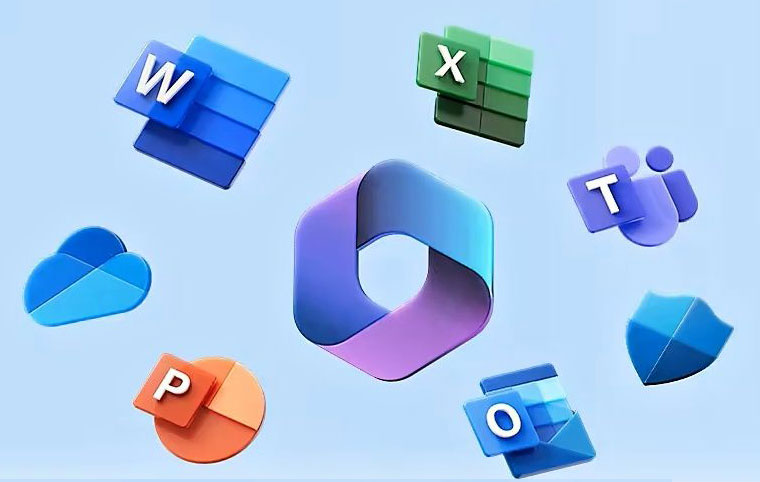
Microsoft Office is a suite of productivity software tools developed by Microsoft, catering to diverse user needs. Comprising popular applications like Word, Excel, PowerPoint, Outlook, and Access, it enables users to create, edit, and share documents, spreadsheets, presentations, emails, and databases seamlessly. With a user-friendly interface and robust features, Microsoft Office has become a global standard in business, education, and personal computing. Its collaborative capabilities through cloud services like Microsoft 365 enhance real-time collaboration, making it an essential tool for professionals and students alike. Microsoft Office continues to evolve, adapting to the changing landscape of technology and communication.
Microsoft Office Benefits for Students
If you’re a student, you’ve probably used Microsoft Office to accomplish a school assignment. Whether you’re generating a Word document, organizing data in Excel, or putting together a PowerPoint presentation, Microsoft Office is a powerful tool that can help you get your work done more efficiently.
1. Making Professional-Looking Documents
One advantage of using Microsoft Office as a student is that you may produce professional-looking documents for your assignments. Word allows you to simply format your document so that it looks neat and tidy. You can also add photographs, charts, and other graphics to your document to make it more visually appealing. Word can also help you design a cover page and a table of contents.
- Writing Assistance: Microsoft Word has a spelling and grammar checker to assist students identify typical writing problems, as well as an editor that advises ways to improve writing style, clarity, and conciseness. Additionally, students can use the thesaurus and translation services to improve their writing.
- Research Tools: Microsoft Word enables students to insert and manage citations, footnotes, and bibliographies, allowing them to correctly reference sources and avoid plagiarism.
- Formatting Options: Microsoft Word provides formatting tools for students to create professional-looking documents, such as headings, fonts, styles, and themes.
- Accessibility Features: Microsoft Word’s accessibility capabilities include adding alt text to images, creating accessible tables, and using built-in templates.
- Collaboration and Sharing: Microsoft Word enables real-time document collaboration, facilitating group projects, note-taking, and discussion among peers.
2. Organizing and Analyzing Data in Excel
Another advantage of Microsoft Office for students is its capacity to organize and analyze data in Excel. Excel is ideal for keeping track of your grades and calculating your GPA. Excel can also be used to arrange other types of data, such as research data for a paper or information about potential universities. Excel may also evaluate the data using its built-in formula and graphing tools.
- Data Analysis: Microsoft Excel is a strong data-analysis application that is especially beneficial for those studying mathematics, statistics, and economics.
- Organizing Information: Excel’s spreadsheet structure is perfect for managing huge volumes of data, such as class schedules, assignments, and grades.
- Graphing and Charting: Excel’s charting and graphing tools help students view and convey data more effectively, which is useful when presenting research findings and analyzing patterns.
- Financial Planning: Excel’s capacity to execute sophisticated financial calculations makes it an invaluable resource for those studying finance, accounting, or business.
- Collaboration and Sharing: Microsoft Excel’s ability to share and collaborate on spreadsheets in real time allows students to work on group projects, analyze data together, and track assignment progress.
3. Creating Engaging Presentations
PowerPoint is another important tool in Microsoft Office for students who need to prepare presentations for their lessons. PowerPoint allows you to effortlessly add photos, movies, and animations to your presentation to make it more engaging. You may also make custom slide layouts and use built-in templates to save time when putting together your presentation.
- Presentation Capabilities: PowerPoint allows students to make visually appealing and engaging presentations that engage audiences and successfully express their ideas.
- Multimedia Integration: PowerPoint allows students to add multimedia elements such as images, audio, and video, which can help to enhance their presentations and make them more engaging.
- Organization and Structure: Organization and Structure: PowerPoint’s slide structure allows students to organize their presentation into clear and concise sections, making it easier for their audience to follow.
- Collaboration and Sharing: Microsoft PowerPoint enables real-time collaboration on presentations, facilitating group projects, note-taking, and idea-sharing among classmates.
- Practice and Feedback: Use PowerPoint’s presenter view to practice and receive feedback on timing and content, enhancing public speaking skills.
4. Collaborating with Classmates and Teachers
Finally, Microsoft Office gives facilities for students to work on shared papers with their peers and teachers. OneDrive is a cloud storage service included with every Microsoft Office 365 subscription.
OneDrive allows you to upload documents for others to view or modify from anywhere with an internet connection. This is especially handy when working on group projects where not everyone is able to meet in person to collaborate.
- Access to Microsoft Office Suite: Students with a Microsoft 365 subscription get access to the newest versions of Microsoft Office applications such as Word, Excel, PowerPoint, Outlook, and OneNote, which can be utilized for academic purposes.
- Cloud Storage: OneDrive allows students to save and access files from any device, making it ideal for group projects or learning on the fly.
- Collaboration and Sharing: Microsoft 365 enables real-time collaboration on documents, spreadsheets, and presentations, facilitating group projects and discussions among classmates.
- Online Learning Resources: Microsoft 365 offers online learning resources such as templates, tutorials, and training materials to help students build new abilities and improve their academic performance.
- Accessibility and Inclusivity: Microsoft 365’s accessibility capabilities, like dictation and text-to-speech, enable students with impairments to utilize the software efficiently.
Microsoft Office Benefits for Professionals
Microsoft Office is a strong set of tools for keeping professionals organized, collaborating with colleagues, and creating professional documents. Microsoft Office includes something for every professional, from report and proposal creation to data analysis in Excel to email management and scheduling in Outlook.
1. Making Professional Documents in Word
Microsoft Office includes various programs for creating professional-quality documents such as reports, proposals, and contracts. Word is a good tool for this type of assignment since it allows users to effortlessly format text and insert photos, tables, charts, and other graphics.
The built-in templates allow you to get started quickly—all you must do is add your own material. Word provides version control tools for complex documents with several components or versions, allowing you to keep track of all changes made over time.
- Document Creation and Formatting: Microsoft Word is a sophisticated tool for generating and formatting professional documents including reports, proposals, and business letters. It offers a range of formatting options, including fonts, colors, and styles, to ensure a uniform and polished appearance.
- Collaboration and Sharing: Microsoft Word enables real-time document collaboration, allowing professionals to edit, evaluate, and track changes for quality and completeness.
- Automation and Integration: Microsoft Word provides automation and integration tools, such as mail merge, macros, and add-ins, to streamline workflows, decrease repetitive activities, and increase efficiency.
2. Analyzing and Visualizing Data in Excel
Excel is a must-have tool for professionals who need to analyze data or produce charts and graphics. Its user-friendly interface allows you to easily insert data into cells and convert it into useful information that can be analyzed or presented graphically.
Excel’s advanced capabilities, such as PivotTables and the VBA scripting language, enable you to swiftly summarize massive volumes of data into simple representations that provide insight into trends or patterns in the data.
- Data Management and Analysis: Microsoft Excel is a sophisticated tool for handling and analyzing vast volumes of data. It includes capabilities for sorting, filtering, and displaying data, allowing for educated judgments.
- Automation and Integration: Microsoft Excel’s automation and integration features, including macros and add-ins, can assist streamline workflows, decrease repetitive operations, and increase efficiency.
- Financial Modeling and Forecasting: Finance and accounting professionals use Microsoft Excel for financial modeling, planning, and forecasting, including calculating complicated financial indicators like net present value, internal rate of return, and payback time.
3. Leaving an Impact on Your Audience with PowerPoint
PowerPoint is an invaluable tool for professionals looking to effectively communicate their ideas and leave a lasting impact on their audience. It is commonly used in a variety of businesses to prepare presentations for meetings, conferences, and training sessions. Its versatile tools for structuring and arranging material, as well as its ability to include multimedia elements, make it an excellent platform for delivering effective and entertaining presentations.
- Presentation Creation and Design: Microsoft PowerPoint provides a range of themes, templates, and design options for professional presentations, ensuring a consistent and visually pleasing appearance.
- Multimedia Integration: Microsoft PowerPoint’s multimedia integration enables professionals to create dynamic presentations with photos, videos, and audio that engage audiences.
- Collaboration and Sharing: Microsoft PowerPoint’s collaboration and sharing tools, including real-time co-authoring and version control, enable professionals to collaborate on presentations, share feedback, and ensure the final output meets expectations.
4. Managing Email & Scheduling with Outlook
Outlook is ideal for managing both personal inboxes (such as Gmail) and professional emails. Outlook allows you to easily organize emails into folders or tags, filter out unwanted messages from your inbox using rules, search through your emails quickly using its powerful search engine, schedule meetings with colleagues or clients using its calendar feature, set reminders for important tasks or events to ensure nothing falls through the cracks, and much more.
- Email Management: Microsoft Outlook offers email management capabilities such as organizing, prioritizing, and categorizing, as well as scheduling and reminders.
- Calendar Management: Microsoft Outlook’s built-in calendar tool helps professionals manage their schedule, set reminders, and organize meetings with colleagues.
- Integration with Other Tools: Microsoft Outlook seamlessly integrates with other Microsoft Office tools, including Word, Excel, and PowerPoint, as well as third-party tools like Dropbox and OneDrive. This allows professionals to manage their work and collaborate with colleagues.
5. Stay Connected Using Microsoft Teams
Microsoft Teams is a communication tool that allows professionals to collaborate in real-time, regardless of their location. Microsoft Teams makes it easier for teams to interact and collaborate on projects by providing capabilities such as chat, video conferencing, file sharing, and document collaboration, as well as enabling for a more flexible and remote work environment.
Its connectivity with other Microsoft Office tools allows for seamless collaboration across several programs, making it a perfect platform for professionals looking to work more efficiently and effectively.
- Real-Time Collaboration: Microsoft Teams offers real-time collaboration amongst professionals, regardless of location, using tools like instant messaging, audio and video calls, and screen sharing, facilitating teamwork and idea sharing.
- Integration with Other Tools: Microsoft Teams interfaces with other Microsoft Office tools, including Outlook, OneDrive, and SharePoint, as well as third-party solutions, enabling professionals to collaborate on papers and files across several programs.
- Project Management: Microsoft Teams’ project management capabilities, including task lists, calendars, and progress monitoring, help professionals manage projects and meet deadlines. It also allows you to set up channels and teams to help with communication and collaboration on certain projects or departments.
Finally, Microsoft Office provides a full array of tools to help students and professionals improve their productivity and efficiency.
Its robust features for document creation and design in Microsoft Word, data management and analysis in Microsoft Excel, and presentation creation and collaboration in Microsoft PowerPoint make it an indispensable tool in academic and professional settings.
Furthermore, Microsoft Teams and Outlook provide a unified platform for collaboration and communication, allowing people to work together regardless of their location. Consider using the whole suite of Microsoft Office applications to increase productivity and optimize your process.
From managing your schedule and tasks with Outlook to collaborating in real-time with Microsoft Teams, Microsoft Office has everything you need to succeed. So, whether you’re a student or a professional, let Microsoft Office help you achieve your goals and enhance your productivity.
That is why Skill with Limithuna offers a Microsoft Office course that will help you become a Microsoft Office expert.
